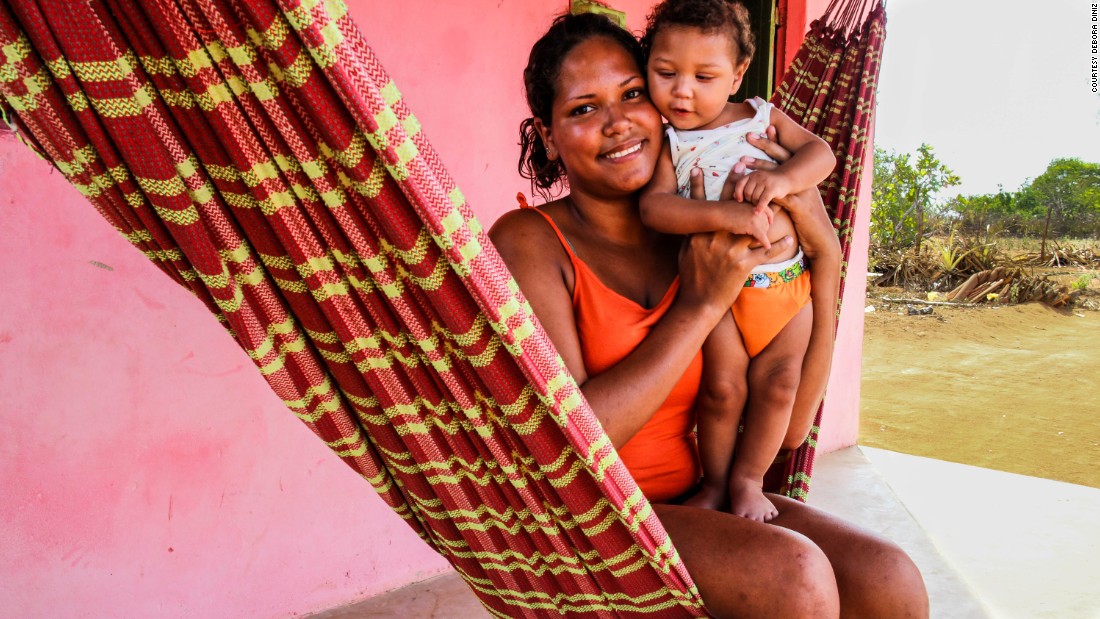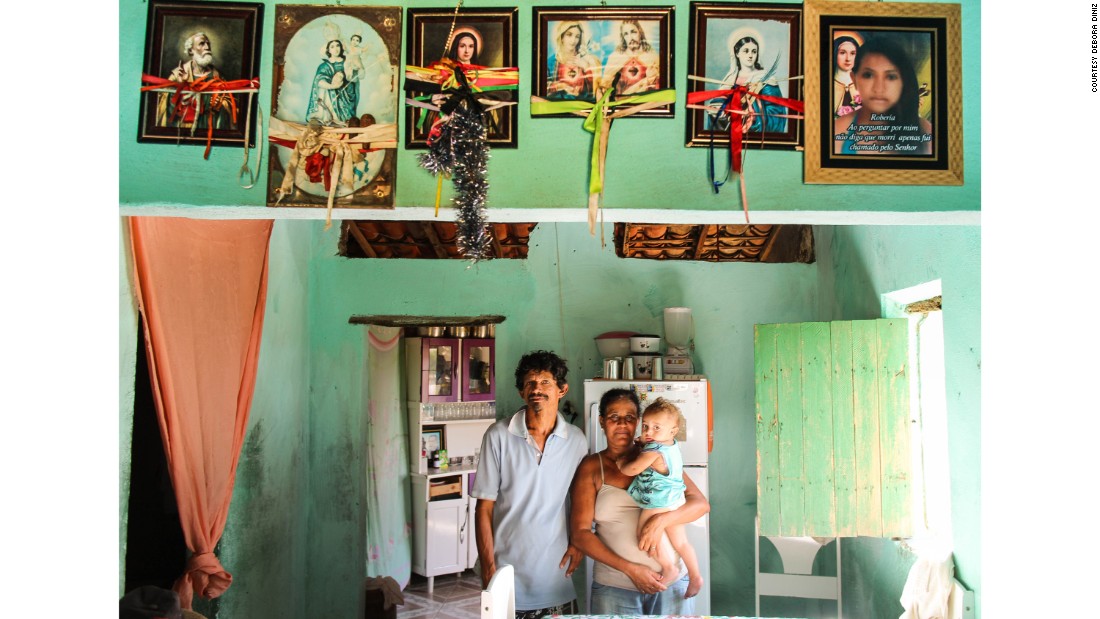por Sandee LaMotte
Publicado originalmente na CNN
Barely more than children themselves when they give birth, many of the forgotten mothers of Zika-striken babies in the Brazilian state of Alagoas are shiny-new teenagers, just learning to navigate their developing bodies.
Traversing the challenges of motherhood at that age is tricky at best; attempting to navigate them with a baby who carries the mark of the mosquito is almost unthinkable.
Rakely Santos da Silva was only 15 when she gave birth to her “special” child. She told women’s rights activist Debora Diniz, who was traveling across Alagoas interviewing mothers of babies affected by Zika, that she had no idea her daughter, Mirela, had congenital Zika syndrome when she was born.

“Special” has a religious meaning for mothers like Rakely, says Diniz, because only “special” mothers can take care of special babies. “You are the one that God knows is strong enough to take care of a baby with a strong dependency.”Rakely’s doctors never mentioned the possibility, even though there were obvious issues with Mirela’s eyes and muscle tone, because her baby didn’t have the typical “small head” of microcephaly, a rare nervous system disorder in which the brain and head fail to develop properly.Yet many babies can have Zika’s hallmark symptoms of eye damage, brain calcification and joint and muscle stiffness without a small head at birth.
Children born with congenital Zika syndrome could have swallowing and feeding difficulties as well as hearing and vision loss. They are also at high risk for seizures or severe developmental delays in moving, speaking, playing and learning.”She should have been invited to a second visit to the hospital to see if the baby was fine and given access to early intervention to improve her baby’s chances at a more normal life,” said Diniz, a Brazilian native and law professor at the University of Brasília. “But that didn’t happen.”Instead, Diniz said, Rakely’s case was discarded, and she and her daughter were added to the list of women and babies considered lucky to escape the ravages of the Zika epidemic.
As a result, Mirela received none of the checkups, medications and developmental resources to which she was entitled.

Mayara Santos de Oliveira and her son, Alejandro Carlos Oliveira da Conceição, live near the coast in Maragogi, Alagoas, not far from all-inclusive tropical resorts.
Mayara Santos de Oliveira was 16 when she gave birth in Maragogi, Alagoas, to her “special” baby, a boy named Alejandro. If she had a fever, a rash or muscle aches during her pregnancy, Mayara didn’t recognize them as typical symptoms of Zika.
“These women have been living with tropical diseases for a long time,” Diniz said. “They told me, ‘I felt some pain in my body but nothing different from everyday life.’ Dengue, chikungunya, malaria, it’s just another experience of the body.”

Maria José Santos de Araújo and her daughter Melissa Vitória live in Japaratinga, Alagoas, close to the ocean.
Maria José Santos de Araújo had her first baby at 16 and her third, Melissa Vitória, when she was 20. Melissa Vitória was born with microcephaly, the abnormally small head and brain that is the hallmark of Zika’s devastating effect on a developing fetus.
Maria — who likes to be called Neguinha, a common term of endearment in Portuguese that roughly translates to “sweetie girl” — told Diniz she had no idea she was carrying a “mosquito baby” until the midwife announced the news with horror at the birth.
In a memory Neguinha described to Diniz tearfully as the “greatest offense,” the midwife asked, “Are you going to take her home, or are you going to leave her here?”

Cryslane was 21 when she gave birth to Hiago in Santana do Ipanema, but she told Diniz she still wasn’t prepared for the stress of caring for a Zika-affected child.
These girls, and others like them, are raising their Zika-stricken newborns in Alagoas, a tiny state in Brazil’s poverty-stricken northeast nestled between Pernambuco and Bahia, the epicenter of the 2015-16 Zika epidemic.
Though most states in the northeast of Brazil show startling numbers of Zika-related pregnancies and births, the official numbers in Alagoas are low. That struck Diniz — who is also a writer and documentary filmmaker who has made numerous films about Brazil — as more than odd.
“There’s no good reason to believe the epidemic had bypassed the state,” she said. “Alagoas is a small, forgotten area, with one of the highest adolescent pregnancy rates in the country. So there’s no way to believe that.”
In December, with funding from the UK’s Department for International Development and the English charitable organization Wellcome, Diniz and several of her colleagues from ANIS, the Institute of Bioethics, Human Rights and Gender, traveled to Alagoas. In the 45-day trip, they visited 21 municipalities, over half of which had officially registered cases of children affected by Zika.
As they entered each town, they went to the local “taxi/motorcycle” stand and asked drivers whether they knew of any babies affected by Zika. When the answer was yes, they hired a ride to their homes.
“We didn’t follow official numbers or data,” Diniz explained. “Instead, we did a home-by-home registration of women who had babies affected by Zika.”
What the team found was disturbing.
Of 49 women included in the study, 10 had babies with Zika who had been discarded from the official count. In fact, Diniz said, Alagoas has twice as many discarded cases per live births as the neighboring state of Bahia. One of the main reasons: Alagoas, unlike other Brazilian states, requires a computerized tomography (CT) scan of a newborn’s brain to add them to the official count. Only two hospitals in the state own a CT machine; the waiting list for the test is months long.
There’s more.
None of the Zika-affected babies Diniz and her team evaluated was receiving proper followup care. Forty-five percent were not receiving early stimulation, over half did not regularly take essential medications, and none of the babies had received the eyeglasses necessary to correct the widespread ocular damage that frequently occurs.

Patrícia Santos da Silva and her six children. She is holding baby Gabriel, who has what she calls the “tiny mosquito problem.”
Patrícia Santos da Silva, 24, and her family live in the city of Santana do Ipanema, in the western backlands of Alagoas. Her son Gabriel, who has what she calls the “tiny mosquito problem,” is her sixth child; she had her first when she was only 14.
Despite a full list of prescriptions that she showed Diniz, including one for seizures, Patrícia shared that she does not buy or receive any of them for Gabriel. Nor does she take him to the doctor or to many of his “early stimulation sessions,” therapy appointments designed to improve muscle tone and bolster development.
The biggest reason: She cannot leave her other children to take Gabriel, nor does she have any money to hire help or transportation.

Neguinha must travel 80 miles one way to get the early stimulation services her daughter needs.
Neguinha faces the same situation. There are no early stimulation services in Japaratinga, where she lives. The closest center is in Maceió, over 80 miles (130 kilometers) away; the only other center in all of Alagoas is in Arapiraca, 174 miles (280 kilometers) away.
To get to the Maceió center, Neguinha must walk for 30 minutes to the local health department to catch a 4 a.m. ride. After several early morning treks only to find that the car was already filled, she gave up.
It’s the same desperate story for all of the women Diniz surveyed, as they struggle to care for their families.
Even by Brazilian standards, Alagoas is one of the poorest and most dangerous states in Brazil, scarred by the drug trade, a high murder rate and ingrained, extreme inequality, especially for women.

Grandmothers are often called upon to help with child care. Maria de Rosilene is the primary caregiver for her grandson, Eduardo, who cannot walk. “It’s hard for Maria because he is getting heavy,” said Diniz.

Tamires Goldino Filho with her husband, Eduardo, and son João Lucas. They must travel two hours each way from their home in Monteiropolis, Alagoas, to get physiotherapy for João Lucas.
“These women were ignored before the arrival of the Zika epidemic,” Diniz said. “They are low in social class, education, culture. They are unknown women in the political world, and they are the most vulnerable.”
Where these women live, substandard housing is the norm, and stagnant water, the breeding ground for the Zika-carrying mosquito, is everywhere.
“They cannot avoid the bite,” Diniz said. “Yet they are not given access to reproductive help, no education or contraceptives, so how can they avoid a pregnancy? And of course, abortion is rarely an option.”
Brazil, like many South American countries, has strict laws against abortion, allowing it only when a woman is raped, her life is in danger or the fetus has anencephaly, a fatal congenital brain disorder. Women who circumvent the law face sentences of up to three years in prison.
Advocates like ANIS, Human Rights Watch and Brazil’s National Association of Public Defenders have been battling the law in court, including one case that cites the Zika virus epidemic. But conservative lawmakers have fought back, introducing bills that might apply a total ban on abortion.
In the meantime, wealthy Brazilian women have the means to obtain safe, albeit illegal, abortions. The poor and disadvantaged go without or endanger their lives in back-alley clinics or by off-label use of potentially dangerous medicationspurchased on the black market.

João Henrique, who has microcephaly, with his grandmother and grandfather in São José da Tapera. His mother, Robéria, died two months after giving birth.
Most of the women in Alagoas have no money to pursue illegal options anyway. If there is no other family member who can help, the women cannot work, Diniz said, because of the special needs of a Zika-affected child. The government provides a stipend, called a cash benefit transfer, but the strict requirements of the law make it a “poverty trap,” she said.
“According to the law, the parents cannot work, because if they have any paid work, they will be above the cutoff,” she explained. “So, in reality, they must live on $200 USA a month. Rent will be 50% of that. It’s a kind of nightmare.”
It’s a nightmare that continues each day for these women and their families, even though the Brazilian government announced an “end” to the Zika outbreak in May, after the number of new cases fell dramatically.
“For these women, the classic idea that the Zika epidemic has a beginning, a peak and an end is a fable,” Diniz wrote in her final report. “The abandonment they experience is not the result of the birth of a child with special needs, but of the fragility of social policies, particularly those related to social assistance, health, and transportation.”

Rosana Sampaio da Silva and her son, Samuel Emanuel, who has microcephaly. Rosana quit her job as a teacher, but her husband’s salary cannot pay for medications or visits to early stimulation treatments in Maceió, an hour away.
As for the women who have never been counted in the official totals, who have no access to any government assistance, Diniz is worried. How many more are out there? How many who will be bitten and deliver babies in the next wave of Zika?
“There are many women like these across Brazil who were discarded cases, not identified, not followed, not given help, and now the world has forgotten because the epidemic is over,” she said, her voice rising.
“We still have cases of women having Zika during pregnancy and giving birth to babies who are affected by the disease,” she continued. “There is no end to an epidemic when the mosquito is still there, still biting, and can be passed on by men as well because it is a sexually transmitted disease.”